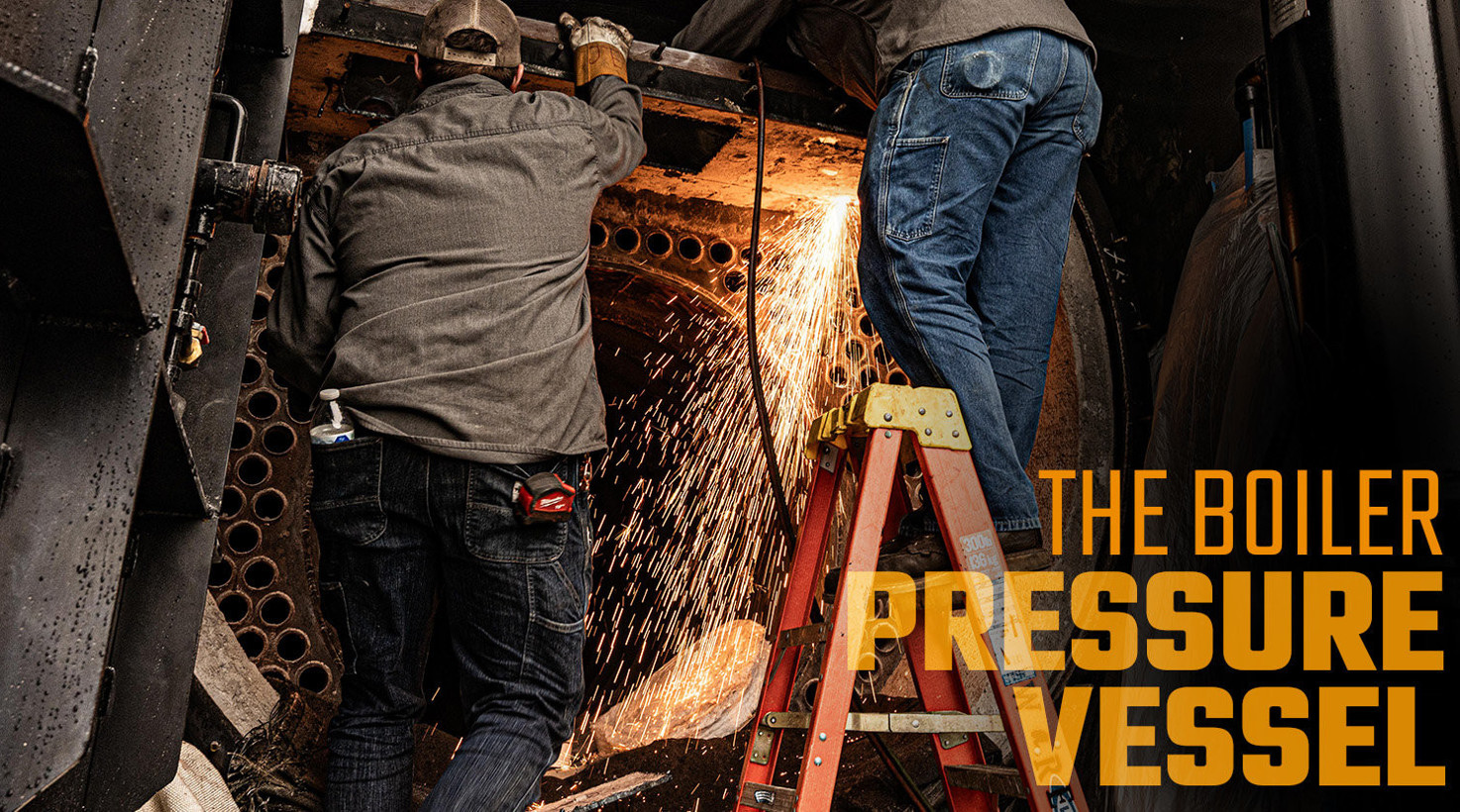If you’ve ever seen a boiler in person (which you have), you probably noticed a firetube boiler has an enormous cylindrical tank. That’s the boiler pressure vessel, and it serves two very important functions in your boiler’s operation: heat transfer and steam collection.
HEAT TRANSFER
The pressure vessel is, in a sense, where the magic happens. Whether you have a fire tube or water tube boiler, the phase change from water to steam is going to happen inside the pressure vessel. But it’s not just a big tank. Inside, there are a series of tubes that serve a different function based on the type of boiler you have.
In a FIRE TUBE boiler, those tubes contain hot combustion gases. They pass through the pressure vessel, which is filled with water. As the heat is transferred through the walls of the tubes, the water heats up until it becomes steam.
In a WATER TUBE boiler, those tubes are filled with water that circulates as hot combustion gases are applied to it. As steam forms, it rises above the water and collects in the steam drum.
REPAIRING A PRESSURE VESSEL
The world isn’t perfect, of course, and sometimes pressure vessels can become damaged. This usually happens when the pressure vessel is subjected to conditions outside its operating parameters.
If a boiler’s water level gets too low, the metal can become stressed and lose its integrity.
If water isn’t treated correctly, that can cause the formation of scale. That’s a problem because scale acts as an insulator, which can reduce heat transfer efficiency. When that happens, the metal can become stressed because the heat isn’t flowing through at the same rate across the pressure vessel’s surface.
If corrosion is allowed to form, whether through improper maintenance or impurities in improperly treated water, the pressure vessel may experience material loss. That, in turn, can result in weaker areas in the pressure vessel.
Repairing a pressure vessel is an exacting procedure that requires a lot of skill and expertise. One common method for repairing a damaged pressure vessel is called “flush patching”, which involves removing the affected area and replacing it with new metal. When a flush patch is required, it must be carefully welded into place, and the welds have to be checked for integrity. Checking them can be done in several ways.
The surfaces of the welds can be checked by dye penetrant testing or mag particle testing.
Dye penetration involves coating the welds with an easily visible dye, which will seep through any cracks in the weld. By checking the other side of the metal after the dye has been applied, the weld’s integrity can be verified.
Mag particle testing is a more sophisticated process that involves magnetizing the surface that has been welded. Once the surface has been magnetized, metallic particles are applied to the weld. Any cracks or gaps in the weld will create disruptions in the magnetic field, and those magnetic particles will tend to collect in those areas.
Testing the entire weld involves one of two different methods, ultrasonic testing or X-ray testing.
Ultrasonic testing involves treating the surface of the weld with a substance known as a “couplant” that is very good at transmitting sound waves. Once the surface has been treated, ultrasonic sound waves are passed through the weld and monitored. Any variation in the sound waves indicates the presence of a defect in the weld.
X-ray testing is just what it sounds like. The welds are X-rayed, and those images are carefully reviewed by an expert to make sure there are no defects anywhere in the weld.
TUBE REPLACEMENT
If the boiler has been subjected to stress, it’s not always the pressure vessel surface that takes the hit. The tubes themselves can become damaged if the boiler is taken beyond its specified conditions. In fact, sagging, discolored, flaking, or scaling in the tubes can be the first sign of a boiler that’s been operated beyond its specifications. That’s because the tubes are thinner than the rest of the pressure vessel. They have to be thin, of course, because that’s where the heat transfer happens.
If the tubes are damaged, they must usually be replaced. Severe damage in a firetube boiler may require the replacement of the tube sheet, but in cases of minor tube damage, the new tubes may be able to be fitted into the existing tube sheet. Once repairs are complete, every component is properly tested to make sure the pressure vessel and its components will operate properly and safely.
If you’re having issues with your pressure vessel, or if you suspect your boiler may have overheated or had a low-water situation, the experts at WARE are here to help you get back up to safe, efficient operation. If your boiler’s running just fine, we also offer the largest selection of online parts and supplies to keep it running at our BoilerWAREhouse.com website. If you’d like to know more about how your boiler operates, we’ve got you covered there, too. Consider taking a class or two at WARE’s Boiler University. Whatever you need, we’re here to help. Just let us know.
